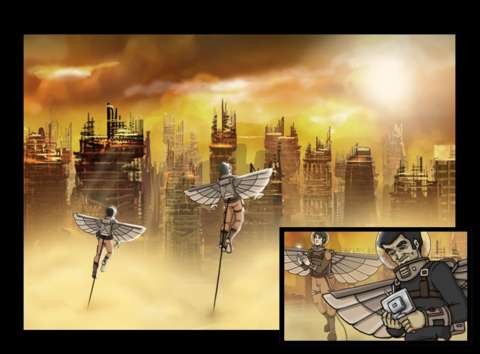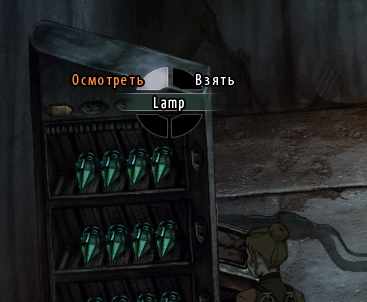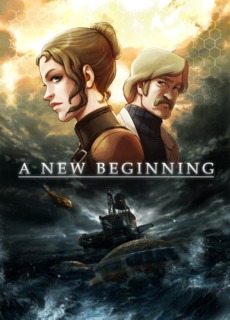INTRO:
Themes of environmental conservation do not appear often in games, much less adventure games because these themes do not make for convenient puzzle designs.
However, perhaps in an eagerness to show that this can be done, Daedalic Entertainment has decided that it should make an adventure title with such themes, albeit with a rather generic-sounding title.
Although the game has the usual hallmarks of Daedalic Entertainment games such as characters that have droll wit, the game also has many issues that are endemic to Daedalic’s titles during the time before it became a full-fledged publisher.
PREMISE:
The themes of environmental conservation permeate the tale that the game is trying to tell.
The game starts with Bent Svensson, a Norwegian former scientist that is trying to recover from a mental breakdown after having spent too much of his life in his research for alternative eco-friendly energy sources. Unfortunately, his hermitic getaway would not last long, because it would be disturbed by young woman with strange clothes and an even stranger story to tell.
Then, the game introduces Fay. She is from the future, which is bleak after Earth has suffered terrible ecological disasters. Intent on preventing the doom of humanity, she is part of a mission to change the past by travelling back in time to right some wrongs – starting by trying to convince Svenson to go back to his research that he is trying to abandon.

Unfortunately, fate is very fickle, and not everything would go according to plan.
STORY-WRITING:
Some players might perceive the trope of time-travellers who are trying to fix things with a paradox as too clichéd for a Daedalic title. Furthermore, this setting is used together with other sci-fi elements to conveniently produce plot devices that are intended for suspense, such as messages from the future that certain characters would receive via the use of an arcane technological device.
Aside from the sci-fi settings and themes of desperation, the other parts of the game’s writing are a lot more believable. For one, there are characters that are easy to empathize with.
Indeed, their personal stories have been designed to be quite deep, especially in the case of Bent. Unfortunately, poor voice-acting and dialogue writing can ruin the player’s mood; this will be elaborated later.
A New Beginning has some scenarios which have introspective takes on the history of humanity and its development as a civilization. Most of these are veiled criticisms of the excesses of human beings, such as the wars that had happened and the energy-inefficient technologies that had been invented.
Indeed, the game is not too far away from being a bit overbearing with its messages. Fortunately, most of these messages are placed in appropriate scenarios. However, there are some oddly placed ones, such as one about the protection of animals that occurs very early on in the game and which can seem too campy.
SENSE OF HUMOR:
Despite what has been mentioned above, the game is not without a sense of humor.
The game does poke at its sci-fi themes sometimes, and with knowledge of actual physics too. For example, there is one scenario in which one of the protagonists altered a device from discharging blue lasers to red ones, supposedly to make it stronger. Another character would note with disbelief that red lasers actually carry less energy than blue ones.
It also pokes at certain tropes of adventure games, such as protagonists’ tendencies to rummage through things, including those that do not belong to them, and take anything significant. The game does treat this trope a bit more seriously, but a veteran of the genre would likely be smirking when this happens.
Being a Daedelic title, A New Beginning typically has references to its previous games, such as Edna & Harvey: The Breakout. Some are overt, such as a doll of Harvey the Blue Rabbit, while others are more sublime.
The characters’ droll wit only expresses itself some time into the game, but this occurs after the player has realized that the voice-acting and transliteration efforts in the game are very poor, especially when compared to Daedalic’s earlier titles (perhaps with the exception of The Breakout).
CONTROLS:
An anthropomorphic version of a certain item in the game is the instructor for the tutorial, which describes the controls; at first, the instructor can seem a bit weird, but it actually appears again later in the game as a tertiary character.
Anyway, the controls would be familiar to players that have played The Whispered World, Daedalic Entertainment’s earlier game. Unfortunately, this also means that it has almost all of the same issues.
The game is mostly point-and-click of course, but to interact with objects, the player must hold the mouse button down to bring up a dial of options, not unlike what has to be done in The Whispered World. In fact, the dial is even smaller than the one in The Whispered World.
Fortunately, the inventory screen is not something that obscures much of the screen, like it did in The Whispered World. Instead, items go into a toolbar that appears at the bottom of the screen when the player brings it up.
Like in many other adventure titles, items of all kinds can go into the player character’s inventory, regardless of their size and whether the player character could possibly have the space for them or not.
CHARACTER DESIGNS & ANIMATIONS:
The game’s designers have come up with some characters that would have fit the sci-fi themes and the drama in the game’s story. However, the execution and implementation of these character designs would leave much to be desired.
There are the two protagonists, Fay and Bent. The differences between them are more than likely to have been deliberate, in order to create contrast between them.
Fay is apparently young and interestingly comely, traits that some characters would point out. Fay is charmingly ignorant of this while she goes about bumbling and causing mischief in equal measure to achieve the objectives of her mission.
Her visual designs may be a bit odd though. For one, the animation of Fay’s sprite as she walks may elicit a few chuckles from the player; her rump is the most heavily animated portion of her lower body. This results in amusingly awkward walking motions.
Bent is apparently old. He is also slightly hunched and has an antiquated sense of fashion. His reluctance and bitterness clashes against Fay’s hopefulness and naïveté; moments when this happens are seen frequently in the first chapter of the story.
There are other characters, but most of them do not have as much screen-time as these two to be memorable. Perhaps some characters such as the gruff and sometimes ruthless Salvador could have stood out, but poor voice-acting ruins these opportunities; this will be elaborated later.
Most of the time, the characters have appropriate facial expressions for their current situation, but the voice-acting may not match these, thus leading to odd sights.
The other animations that characters exhibit when they perform actions can seem sparse. For example, the player will see characters handing items to other characters; this is a stilted motion, and one that is re-used for many other actions too.
Another example is that characters do not always look at an object when the player has them examining something. Although the game does have them walking over to the object, the game uses their default sprite anyway, which does not show them looking at something.
Of course, one can argue that this has always been the case for many of Daedalic’s games, but in the case of A New Beginning, there is a scenario that is a reminder that this design trope causes disbelief. In this scenario, Bent is bound to something and he appears to be always looking at it. Even though the player can have him looking at other things, he would not even exhibit the appropriate animation of looking at other things.
COMIC BOOK PRESENTATION:
Major developments in the plot are presented via comic-book-like visuals, with a little bit of animation in the panels to better depict that something is happening. This is a neat effect, if only because there has not been a Daedalic title that resorted to such a presentation.
However, an observant person would notice that the comic book panels lack the vibrant artwork that is seen in the rest of the game. The panels often have drab backgrounds whenever they are not using the artwork that was actually used for the locales.
PUZZLE DESIGNS:
Improvisation is the main theme in the designs of the puzzles and solutions in A New Beginning. The player will be slapping together items in unseemly manners and using them as make-shift tools – something that the protagonists will observe, amusingly.
Of course, such puzzles would seem familiar and not too out-of-place to veterans of the adventure game genre. For more discerning players though, they may seem like wasted opportunities to make better use of the settings of the game for something else other than point-and-click puzzle-solving gameplay.
A lot of objects in the game have red herring qualities. These can be seen from picking the interaction options for them. Some of these options serve no other purpose than to yield commentaries from the characters.
Certain puzzle solutions may also seem unbelievable. For example, there is a puzzle solution that has Fay doing something obviously suspicious in front of another character, who does not seem to notice it at all.
Furthermore, some of the lines that the player characters use to describe objects with may give spoilers on what is going to happen next in the progression of the story.
If there is anything worth noting about the puzzle designs, it is that the puzzles that Fay has to deal with tend to have solutions with themes of mischief; this would be nothing new to veterans of the genre of course. In contrast, a few of the solutions for Bent’s puzzles can seem a bit macabre, such as one where he obtained alternative sources for document inking.
Like in Daedalic’s previous titles, some of the logic puzzles can be skipped, if the player does not have the patience for them. Nevertheless, it is worth completing them, if only to listen to the characters’ comments. For example, there is one puzzle where Fay remarks on the silly impracticality of the design of a certain device.
Some of the puzzles also take place in cross sections of buildings. These are done quite neatly, and it is also worth noting here that this is rarely done in adventure games. Furthermore, they also suggest that the game designers have done a lot of research into designing the locales.
Now, one would wonder if only the same effort had been invested into the voice-overs, which will be described shortly.
VOICE-OVERS:
The game has its voice-acting in four languages: English, Deutsch, Françoise and Rússkiy Yazýk. Unfortunately, almost all of them are delivered in a bland manner, as if the voice actors and actresses are merely reading off scripts and the voice director could not really care less to evoke better performances from them. The worst voice-overs are the English ones, which have the least enthusiasm.
Of the four, the French voice-acting is at least bearable, but even that one falters into blandness occasionally and at moments where more emotion would have been expected. Moreover, some of Bent Svensson’s French lines are delivered with awkward forcefulness, especially those that remark on how useless an action is.
The voice-acting happens to mar the game’s few attempts at some humor. For example, Fay is a little bit clumsy at times, yet these supposedly light-hearted moments lose their appeal no thanks to the bland voice-acting that suppresses any sense of amusement. Otherwise tense and suspenseful moments are also damaged by the voice-acting.
SUBTITLES:
The game comes with subtitles in a surprising number of languages. In fact, there are more languages for the subtitles than there are languages for the voice-acting.
However, there are some mishaps in the quality control of the translations. An example occurs when Fay makes a remark on a puzzle solution that involved a certain piece of soap. For the English version of this remark, instead of referring to the soap, she mentioned something about a stone instead. The other languages, such as the French one (which refers to the soap as “savon”), do not appear to make the same mistake.
There are also mix-ups in the subtitles and mismatches with the voice-overs, in addition to lags between the voice-overs and subtitles.
Another problem with the subtitles is that it sometimes has the wrong language being used to display the text label on an object. This tends to happen for red-herring objects, so it may seem to be not much of an issue.
Nevertheless, this is one more issue that contributes to the strong impression that there is a lack of thoroughness in the quality control of the game.
TECHNICAL ISSUES:
A New Beginning was one of Daedalic’s earliest games - and this happens to mean that the game is quite technically flawed, due to Daedalic’s then-fledgling experience with Visionaire Studio, the engine that powers the game.
The player characters’ sprites sometimes disappear when the player attempts to use an incorrect item on an object.
Sometimes the mouse cursor goes haywire in certain dialogue trees, such as Fay’s conversation with a certain electrician. This problem transfers to the mouse when it is used outside of the game, and can only end if the player can end the conversation in-game.
The voice-overs sometimes mix up between languages, and at other rare times, they simply fail to play out. These occurrences are very rare, but they are reminders that the game designers had not taken the voice-acting in the game seriously.
The game is inimical to attempts to switch to running programs and back. Problems can occur with Visionaire’s layering techniques, preventing the player character from interacting with objects or even walk out of the screen in bizarre manners. Playing in windowed mode increases the number of issues even further.
The roll of credits does not execute properly, often cutting to a teaser cutscene. This is unfortunate, because one would have wanted to know who was responsible for the poorer parts of this game.

MUSIC:
The audio composition company that is Knights of Soundtrack is Daedalic’s partner for the game’s musical designs. This is not the first time that the Knights have worked with Daedalic before, and it so happens that they made Daedalic’s games far more bearable than their flaws would suggest.
Unfortunately, they may not be able to save this particular Daedalic title from fading into mediocre obscurity. Although the Knights composed many pleasant soundtracks, such as the one for the tutorial-cum-prologue, and some beautiful piano tracks for A New Beginning, the lousy voice-overs would often distract the player from the better sound designs for the game.
This is a shame, because whoever composed the music happens to be more emphatic with the themes and plotline of the game than whoever directed the voice-acting and the quality control for the game.
SUMMARY:
A New Beginning may have a message about environmental protection with a story that is supposed to be thrilling wrapped around it. It even has gorgeous artwork.
Unfortunately, such commendable effort by the story designers and the artists is undermined by the lackadaisical work of their colleagues, namely those who worked on the voice-acting and the writing of the dialogues in the game. The game also suffers from poor quality control, especially in its transliteration efforts.
Considering that the game has been around for a while and its supposedly finalized version, "A Final Cut", still has these issues, this Daedalic title is very difficult to recommend.

